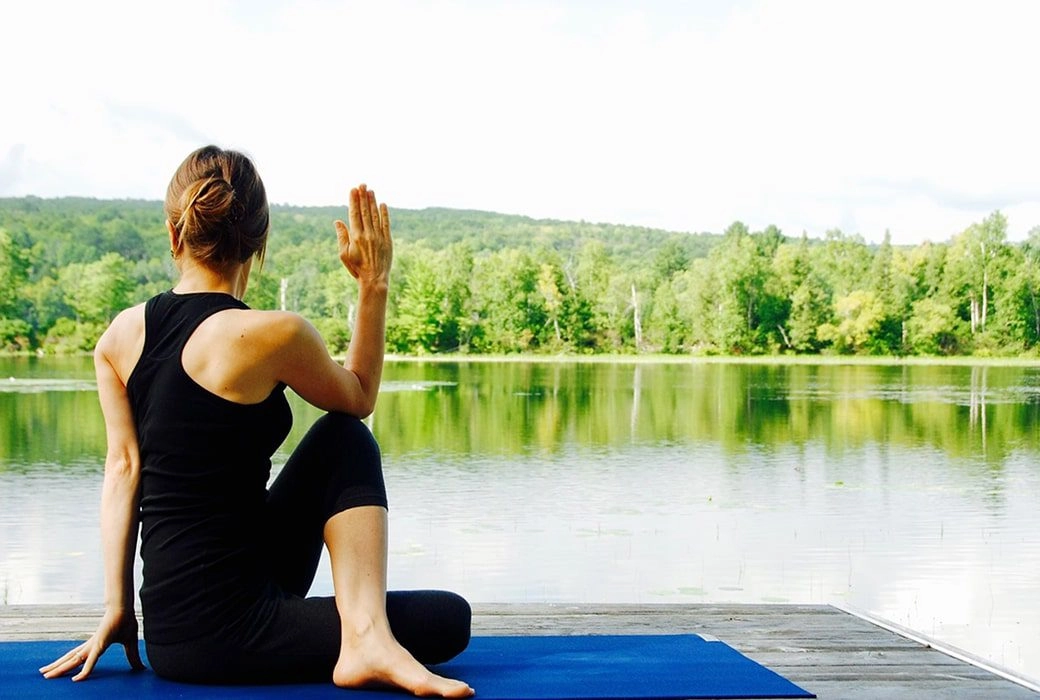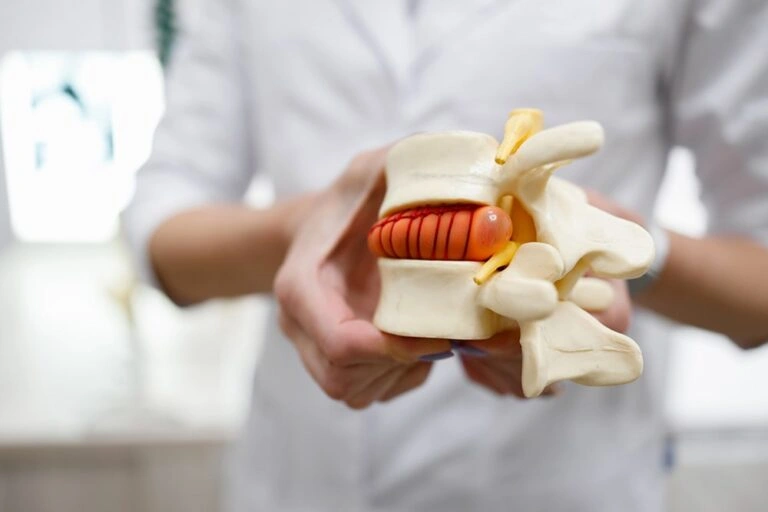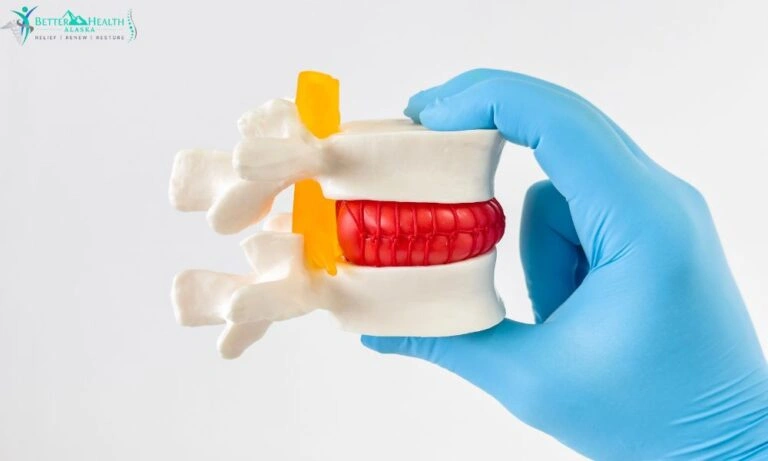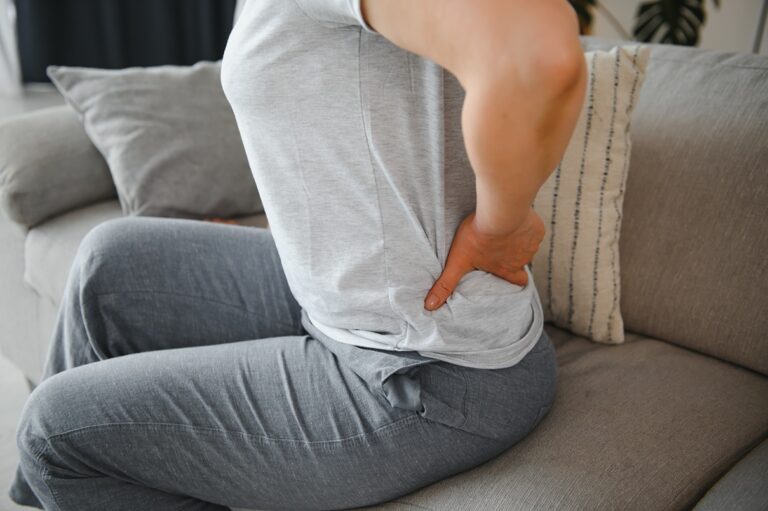Neck pain may be the result of an awkward sleeping position, habitual activity, injury, or health issue that needs attention. Working with the whole body to heal existing pain increases the effectiveness of each exercise task. Building strength and flexibility in the shoulders and upper back will help to support neck muscles, decreasing pain.
Rather than working to absolutely master each stretch, seek to have each stretch benefit you. Progressing and becoming more idyllic in your posture and stretching will, of course, benefit you. However, if your focus is placed more on allowing each task to help you heal, you will likely glean more personal benefits.
1) Seated Upper Body Twist
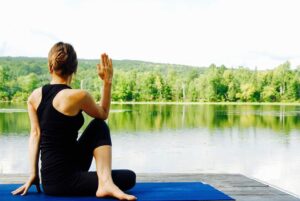
While on the floor, sit straight up with your legs crossed (criss-cross applesauce). Rest your right hand on your left knee. Place your left hand flat on the floor behind you. Turn your head, shoulders, and torso to the left. Keep your shoulders facing left and inhale as you gently bring your head to the right and up. Concentrate on lengthening your spine. Gently return your head back toward the left shoulder as you exhale. Do this for five to eight breaths. Repeat on the opposing side.
- Modification: If you are uncomfortable sitting with your legs crossed, try sitting with your legs straight out in front of you. Slightly bend at the knees. Complete the rest of the stretching technique the same.
2) Triangle Pose
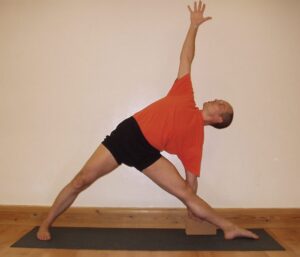
Stand with your feet about four to five feet apart with toes pointing forward. Ensure your heels are aligned with one another. Raise your arms out straight to either side so they rise just above your shoulders. Slowly breathe in and out once.
Turn your left foot outward so that your toes point away from the left side of your body. Allow your right foot to turn inward slightly. Slowly breath in and out once.
Stretch through your left hand and pull it down to the outside of your left thigh or shin. As you are able, bring it behind your left ankle to the floor. Turn your face forward and up to view your right hand in the air. Slowly breath in and out once. Hold for a count of 10. Repeat on the other side. Switch sides three to five times.
Ideally, you want to create a straight line from your left hand, through your upper back, neck, and shoulders through your right hand. This takes practice. Be patient and let your body learn how to do this one with you. It is more important to keep your body aligned than how close to the floor your left hand comes.
- Modification: Hold each side for a count of 30 instead of switching sides. Consider placing your torso or one heel against a wall if you feel unstable.
3) Cobra Pose for the Neck
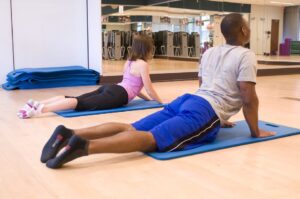
Lay flat on your stomach. Gently turn your head to the right. Place your hands onto your back with the palms up. Lift your chest while breathing in slowly. Breathe out as you lower your chest back to the floor. Switch sides. Complete this stretch four times on each side.
- Modification: While lifting your chest, bring your right hand around and place it on your forehead.
4) Staff Pose
Sit on the floor with your legs straight out in front of you and slightly bent. Lengthen your spine and remain facing forward. Place your palms on the floor by your hips and press into the floor with them. Pull your shoulder blades toward your spine and slightly down. While still pressing into your palms, gently begin to press them in opposite directions. (Your hands are still flat on the floor just push toward the right and the left with your palms still on the floor.) Slowly raise your head and allow your jaw muscles to relax. Focus on your lengthened spine. Hold for 10 seconds. Repeat five to eight times.
- Modification: If needed, you can still gain much of the benefits to the neck and shoulders by completing this stretch from a chair. Ensure that the sitting space is wide enough to allow you to place your hands beside your hips.
5) Cat Stretch
Begin on all fours on the floor. Your hands and knees should be aligned shoulder and hip length apart. Keep your arms straight with a slight bend at the elbows. Draw your spine upward creating an arc with your back (similar to how a cat stretches.) Imagine that you must bring your belly button as close to the ceiling as possible. Gently tuck your chin toward your chest.
Next: Bring your belly button as close to the floor as you can with controlled motion. Do not allow your belly to simply fall into position. Allow your torso to form a semi-circle shape. Keep your arms straight with a slight bend at the elbows. Slowly raise your chin to face upward and straight before you. Move gently allowing your neck, shoulders, and spine to adjust as you go.
- Modification: If needed, this stretch may be completed from a seated position. Simply roll your shoulders forward and press your back into a soft chair while tucking your chin to your chest. In reverse, roll your shoulders backward and bring your belly towards the middle of your lap while raising your chin and relaxing your jaw.
Activities to Avoid with Neck Pain
- Sit-ups
- Crunches
- Front and Rear Neck Bridge
- Let Pulldown (especially with the bar behind your head)
- Military Press
These tasks put pressure on the cervical spine. Keep your vertebrae happy with more neck-friendly exercises and stretches. As with any stretch or exercise, if you feel pain stop.
Be gentle to your body while stretching. It is easy to think that stretching is an easy and relaxed addition to exercising. However, it possible to overstretch or overwork muscles while stretching.
Do not force your body into any stretch position. Get as close as may be comfortable. Be consistent. Our bodies need gentle and regular maintenance. Leave sporadic and forceful actions for the geysers and volcanoes.
Overcoming Neck Pain

Regular daily actions may play a significant role in causing neck pain. Review body placement in all regular activities. Notice times of the day when your neck and spine are bent. Take note of any tasks that cause you to slouch, strain, or crane your neck. Work to alter any activities that may create a recipe for poor posture.
Mixing up activities for the body helps the body develop as a unit and lessens the risk of injury. The neck and shoulder muscles are integral to most of the activities that we choose. We may not realize the full impact our actions have on the vertebrae and muscles in the neck. It is important to provide a variety of movements for the body.
Technology has more benefits than we may choose to count – but it also gives us additional ways to cause strain on the body. Many modern tasks require, or lead us, to place the neck in unfriendly positions. This may add to existing pain or be the cause of pain in the first place.
Leaving the Pain Behind
Pain that has stayed with you for some time, may be the sign of an issue that needs medical attention. Knowing and understanding the source of your pain is the first step toward long-term healing. Neck pain sufferers do not have to retain their pain.
Better Health Chiropractic in has four locations in Alaska designed to help patients work through neck pain and find healing. Contact us to schedule an appointment in your area. Place neck pain behind you and be ready to take on your next realm of adventure!


